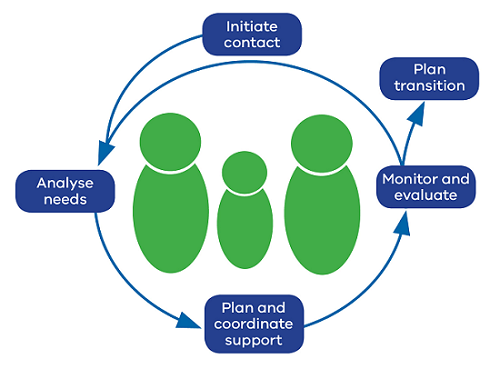Team Around the Learner (TAL) provides a framework for an individualised, holistic and team-based approach to support learners at risk of disengaging, or who have disengaged from education and learning.
Key people work together as a team, coordinate a plan to meet the needs of the learner and support them to continue to engage in, or re-engage in, education and learning.
Team Around the Learner provides a structured framework within a Multi-Tiered System of Support (MTSS) for a whole school approach to support all learners.
TAL aims to:
- provide effective and enhanced support to individuals who are vulnerable, have complex needs or who have experienced disengagement from their learning pathway
- reduce duplication and fragmentation in support to vulnerable children and young people and those with complex needs
- enable an effective and consistent model of practice within the broader departmental
school-wide positive behaviour support framework
- promote a lead professional role to provide a seamless service to children and young people with complex needs through the ages and stages of learning and development.
Key principles
- the learner and family are at the centre
- learners experience a coordinated and seamless service
- promotes positive engagement
- outcomes focused
- a collaborative and collective team effort within a school-wide framework.
TAL pathway
The TAL pathway outlines the phases that need to be in place so that each learner can be supported.

The team around the learner pathway includes 5 phases. This starts with initiating contact, and moves to analyse needs, plan and coordinate support, monitor and evaluate and either finish with plan transition or if further needs are identified, can move back to analyse needs.
For each phase, schools can consider:
-
Initiate contact - How are relationships formed with the student, family and other professionals so that there is a thorough understanding of the context for this learner?
-
Analyse needs - How is information gathered, shared and analysed to determine the underlying causes so that the correct interventions and supports can be planned?
-
Plan and coordinate support - How does the team decide on the most appropriate interventions for the learner and how does each member of the team commit to providing support?
-
Monitor and evaluate - What is the process used for monitoring and evaluating the goals for the learner? How often are these reviewed?
-
Plan and transition - What is the process used for deciding if and when additional supports can be gradually reduced as the learner develops greater independence?
See the support material section for tools and templates to help implement the TAL pathway.
Who is involved
The team is made up of groups of people who are connected to the learner through natural, community and formal support relationships.
- Team members may include the learner, education professionals, health professionals, community members, parents/caregivers, and external agencies involved in the life of the learner and family.
- Lead Professional coordinates the efforts of the team and ensures that all team members are part of the solution
- The team meets regularly regarding the design, implementation and review of a coordinated plan put in place by the team to meet the individual needs of the learner and family.
When to use the TAL approach
The approach can be adopted as early as needs are identified.
Although not all issues experienced by learners are problematic initially, it is beneficial to support the learner early to prevent such issues from impacting their learning.
Support material
High levels of transparency and documentation are important to support collaborative practice, as the team uses the TAL approach, so tools, templates and modules are available to support teams.
Tools and templates
A series of 12 modules that schools can work through to enhance their understanding of the Team Around the Learner approach.